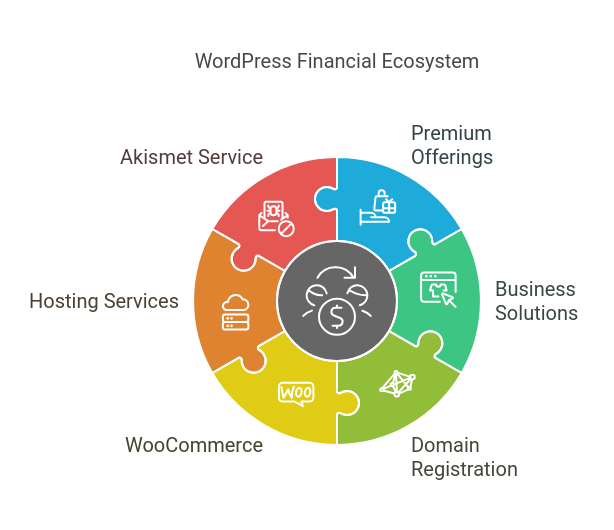WordPress, the world’s most popular content management system, has revolutionized the way websites are built and managed. Its user-friendly interface, extensive customization options, and thriving community have made it the go-to platform for businesses and individuals alike.
The success of WordPress extends far beyond its technical capabilities—it has become a driving force in the global economy. As more people turn to the internet to establish their online presence. WordPress has emerged as a powerful tool for creating and managing websites across various industries.
In this article, we’ll delve into the fascinating world of WordPress, exploring its market share, revenue sources, and the immense economic impact it has had over the years.
What is WordPress?
WordPress is a free, open-source content management system (CMS). That enables users to build and manage websites without requiring in-depth coding skills. Its intuitive interface and vast library of themes and plugins make it an attractive choice for both beginners and experienced web developers.
One of the key factors contributing to WordPress’s success is its extensive collection of themes and plugins. With over 8,100 free themes and 58,000 unique plugins available. Users can easily customize their websites to suit their specific needs. Whether it’s creating a simple blog, a complex e-commerce store, or a professional portfolio.
WordPress is available in two versions: the self-hosted WordPress.org and the hosted service WordPress.com. The self-hosted version offers users complete control over their website, including the ability to install custom themes and plugins, while the hosted service provides a more streamlined experience with managed hosting and support. This flexibility has allowed WordPress to cater to a wide range of users. From small businesses to large enterprises, making it a versatile solution for website development and management.
WordPress Market Share and Growth
WordPress’s position as a leader in web development is evident through its substantial market presence. Accounting for a significant portion of the internet’s websites, WordPress demonstrates its unparalleled status in the content management system landscape. This prominence is particularly notable within the CMS sector, where its usage far exceeds that of its peers. The platform’s extensive capabilities, including a vast array of customization options, have established it as the preferred choice for web creators worldwide.
Over the last decade, WordPress has consistently expanded its footprint, showcasing impressive growth metrics that set it apart from competitors like Shopify, Joomla, and Wix. This upward trajectory reflects its capacity to adapt to emerging trends and integrate new technologies seamlessly. WordPress’s commitment to innovation has allowed it to maintain a competitive edge, continuously enhancing its offerings to meet the evolving needs of its diverse user base.
With a significant portion of new websites choosing WordPress, its reach continues to broaden. The platform’s ability to support a wide range of applications—from straightforward personal blogs to complex enterprise solutions—underscores its flexibility and reliability. As more creators and businesses recognize the importance of effective online tools, WordPress’s role as a foundational element in web development remains robust and increasingly influential.
WordPress Revenue Sources and Valuation
The financial framework of WordPress, generating an estimated $1.7 billion annually, is bolstered by diverse revenue channels. These channels include premium offerings on WordPress.com, which provide users with enhanced customization and functionality options. The platform’s business and eCommerce solutions cater to a professional audience, creating significant income streams.
Furthermore, WordPress capitalizes on domain registration services, allowing users to secure personalized domain names, which adds another layer of revenue.
Automattic, the driving force behind WordPress.com, significantly influences the platform’s financial stature. Valued at $7.5 billion in 2021, Automattic’s growth trajectory is supported by strategic investments from various stakeholders, showcasing confidence in WordPress’s continuous innovation. Beyond WordPress.com, Automattic manages a diverse portfolio that complements the core platform and reinforces its dominant market position.
While WordPress.org offers a free CMS, it also taps into its extensive ecosystem to generate income. WooCommerce is a key player, offering an array of extensions and themes tailored to the expanding e-commerce sector.
Additionally, hosting services and the Akismet anti-spam service contribute to revenue, supported by a community-driven model that fosters voluntary contributions. This comprehensive approach ensures WordPress remains financially robust while delivering ongoing value to its users.
WordPress Ecosystem and Economic Impact

The WordPress ecosystem operates as a comprehensive network that plays a pivotal role in the digital economy. In 2020, WordPress contributed significantly to global economic activity, with a study estimating its influence at $596.7 billion. This influence is set to increase, highlighting the platform’s integral role in not only web development but also broader economic contexts.
Central to this ecosystem is a diverse community of developers, agencies, and enterprises. These contributors leverage WordPress to offer a multitude of services, ranging from personalized website creation to ongoing design and support. The ecosystem thrives on the sale of premium themes and plugins, which further drive innovation and revenue generation within the community.
For professionals engaging with WordPress, several opportunities for monetization exist. Custom development remains a key offering, enabling clients to achieve tailored digital solutions. Design services are equally crucial, as they allow businesses to establish distinctive digital identities.
Additionally, the production and distribution of premium themes and plugins offer a robust business model, catering to the increasing demand for advanced website features and customizations.
WordPress Usage Statistics and Demographics
WordPress’s reach and adaptability are underscored by its impressive usage statistics, showcasing its global influence and accessibility. With approximately 148 million monthly visitors, the platform serves as a vital hub for content creators, developers, and businesses seeking robust digital solutions. Its widespread availability in more than 70 languages enhances its appeal, breaking down language barriers and empowering users worldwide.
The platform’s strength lies in its vast ecosystem, offering a myriad of tools to enhance website functionality and appearance. Users have access to an extensive selection of plugins, allowing them to tailor their websites with features ranging from e-commerce capabilities to enhanced security measures. Complementing these are numerous theme options that enable businesses and individuals to craft visually distinct websites, aligning with brand aesthetics and functional needs.
WordPress’s versatility is evident in its adoption across a diverse user base, including bloggers, small enterprises, and global corporations. It powers 14.7% of the top 100 websites, underscoring its capacity to handle high-traffic demands and complex site requirements. This widespread utilization across sectors highlights WordPress’s reliability and scalability, solidifying its status as a premier choice for those aiming to establish a strong online presence.
WordPress Future Outlook
WordPress’s trajectory showcases its strategic foresight in embracing the evolving digital landscape. As the need for robust online platforms intensifies, WordPress’s commitment to innovation ensures it remains a pivotal choice for varied applications. Its vibrant community and contributions to ongoing development underscore its leadership in the CMS arena.
The allure of WordPress is evident in its ability to offer tailored solutions across different sectors. The platform’s diverse plugin and theme repository empowers developers to craft unique experiences that align with specific business objectives. This extensive customization capability positions WordPress as an essential tool for developers aiming to deliver nuanced and effective solutions.
As digital commerce continues to expand, WordPress’s role in supporting eCommerce initiatives becomes increasingly critical. The platform’s infrastructure is well-suited to handle the complexities of online retail, providing businesses with a dependable solution for their eCommerce needs. Furthermore, the growing interest in decoupled architectures, such as headless WordPress, opens new possibilities for performance optimization, allowing developers to leverage cutting-edge technologies to enhance user experiences.
As WordPress continues to shape the digital landscape, its influence on the global economy remains undeniable. With a bright future ahead, characterized by ongoing innovation and a thriving ecosystem. WordPress is poised to maintain its position as the leading content management system for years to come. Whether you’re a blogger, developer, or business owner, harnessing the power of WordPress can help you achieve your online goals and contribute to the ever-evolving digital economy.








